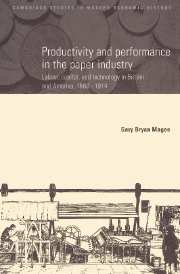 Productivity and Performance in the Paper Industry
Productivity and Performance in the Paper Industry Book contents
- Frontmatter
- Contents
- List of figures
- List of tables
- Acknowledgements
- List of abbreviations
- Introduction
- 1 Background
- 2 Technological change
- 3 Performance
- 4 Rags, esparto, and wood: entrepreneurship and the choice of raw materials
- 5 The Anglo-American labour productivity gap
- 6 Unions and manning practices in Britain and America
- 7 Raw materials, women, and labour-saving machinery: the Anglo-American gap, 1860–1890
- 8 Technological divergence: the Anglo-American gap, 1890–1913
- 9 Free trade and paper
- Conclusion
- Bibliography
- Index
6 - Unions and manning practices in Britain and America
Published online by Cambridge University Press: 16 March 2010
- Frontmatter
- Contents
- List of figures
- List of tables
- Acknowledgements
- List of abbreviations
- Introduction
- 1 Background
- 2 Technological change
- 3 Performance
- 4 Rags, esparto, and wood: entrepreneurship and the choice of raw materials
- 5 The Anglo-American labour productivity gap
- 6 Unions and manning practices in Britain and America
- 7 Raw materials, women, and labour-saving machinery: the Anglo-American gap, 1860–1890
- 8 Technological divergence: the Anglo-American gap, 1890–1913
- 9 Free trade and paper
- Conclusion
- Bibliography
- Index
Summary
In chapter 5 it was argued that, relative to the United States, British paper-mills employed significantly more labour per paper-machine installed. This was most markedly so between 1860 and 1890. In trying to explain this fact, perhaps the best place to start is to determine whether differences in the attitudes of the workforce in each country could have significantly influenced respective practices with regard to the numbers employed per machine or per mill. A major theme of the literature is the hostility of British workers and their organisations to changes that altered the existing customs and arrangements regarding employment in their industry. This was usually a defensive action against technological change that saved on labour and compelled those left to work longer hours for similar or less pay. But these changes were resisted not only because they reduced labour requirements within the workplace, but because they were also often deskilling by nature. In industries where there was a very strong craft-based tradition, the dilution of the trade with the introduction of unskilled labour to operate such new machinery was a tendency that was fervently resisted. This was especially so, because in late Victorian Britain significant social status was ascribed to craftsmen. For their part craftsman revelled in this status, generally regarding themselves as a cut above other workers.
- Type
- Chapter
- Information
- Productivity and Performance in the Paper IndustryLabour, Capital and Technology in Britain and America, 1860–1914, pp. 161 - 173Publisher: Cambridge University PressPrint publication year: 1997


